Abstract
Primate erythrocytes appear to play a role in the clearance of potentially pathogenic immune complexes (IC) from the circulation. This study was undertaken to compare the clearance from the circulation and tissue uptake of two monoclonal IC probes: one of which, IgG1-IC, was bound well by erythrocytes, the other of which, IgA-IC, was bound relatively poorly by erythrocytes. The IC probes were labeled with different iodine isotopes and infused either concomitantly or sequentially into the arterial circulation. The results indicate that, compared with IgG1-IC, IgA-IC bind less well to primate erythrocytes, are cleared from the circulation more quickly despite their smaller size, and show increased uptake in kidney and lung but decreased uptake in liver and spleen. Evidence is presented which suggests that this pattern of clearance from the circulation and systemic uptake of IgA-IC is the result of decreased binding of IgA-IC to circulating erythrocytes. These findings support the hypothesis that the primate erythrocyte-IC clearing mechanism may be critically important for the safe removal of IC from the circulation.
Full text
PDF
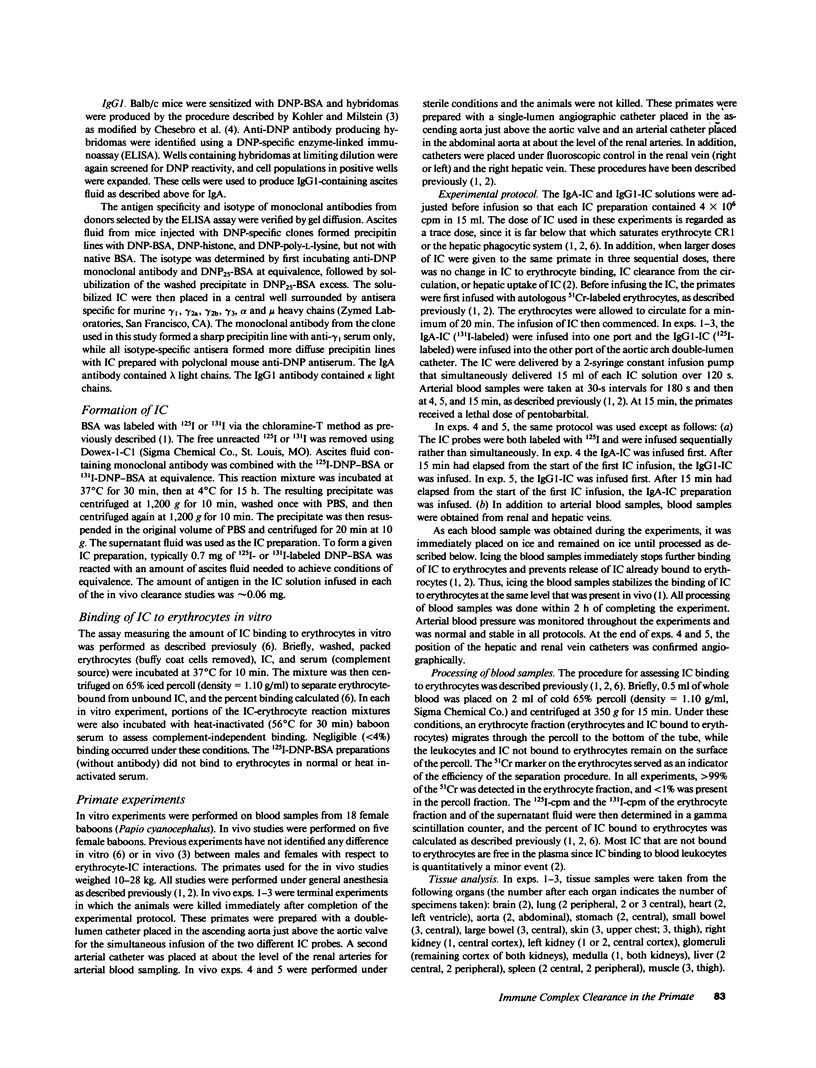
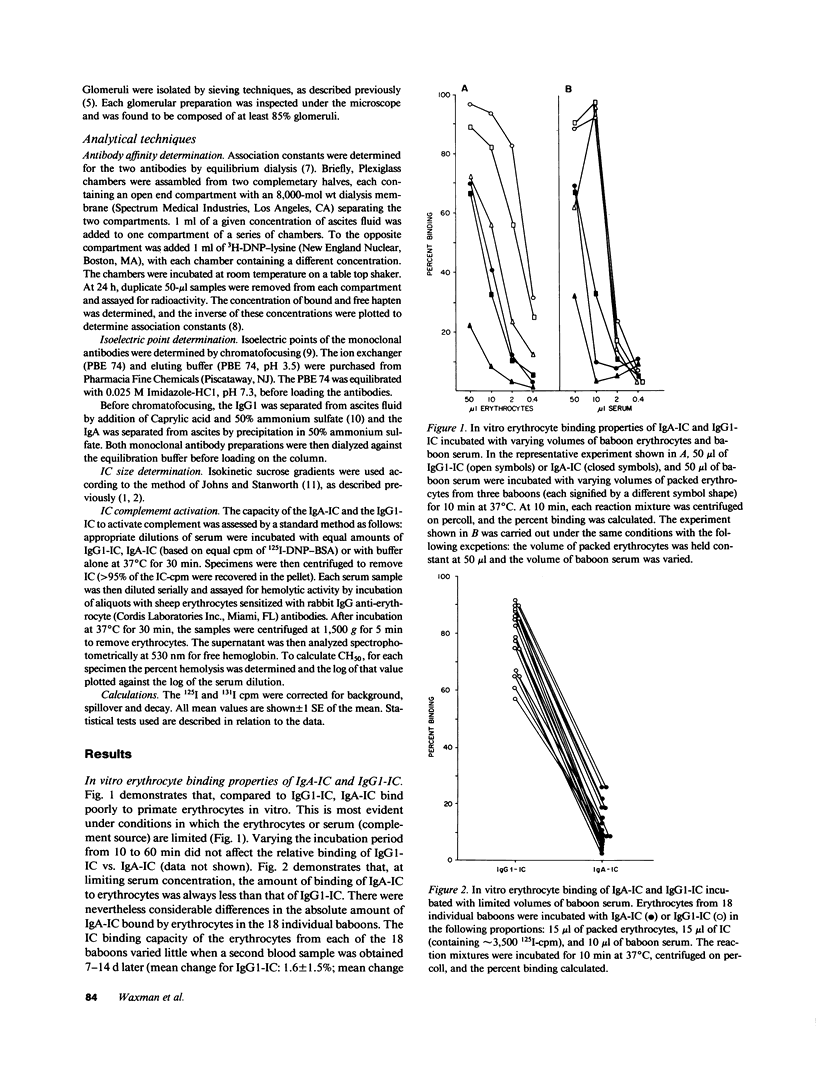
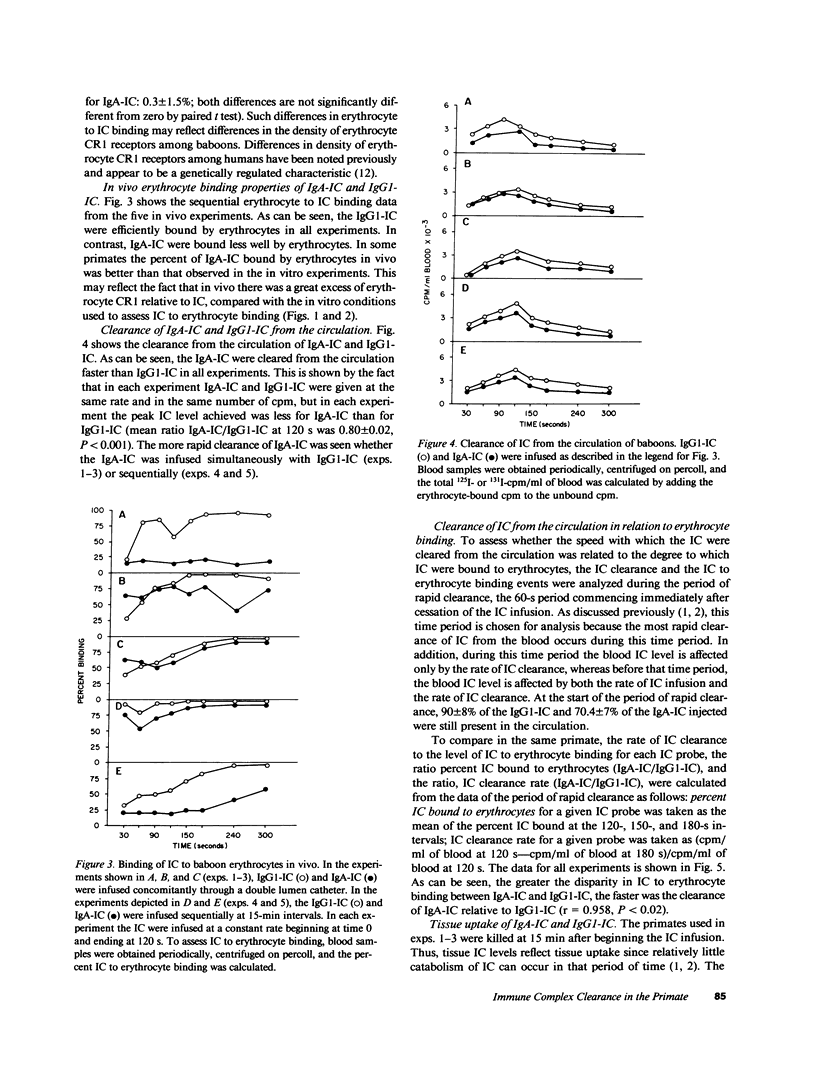
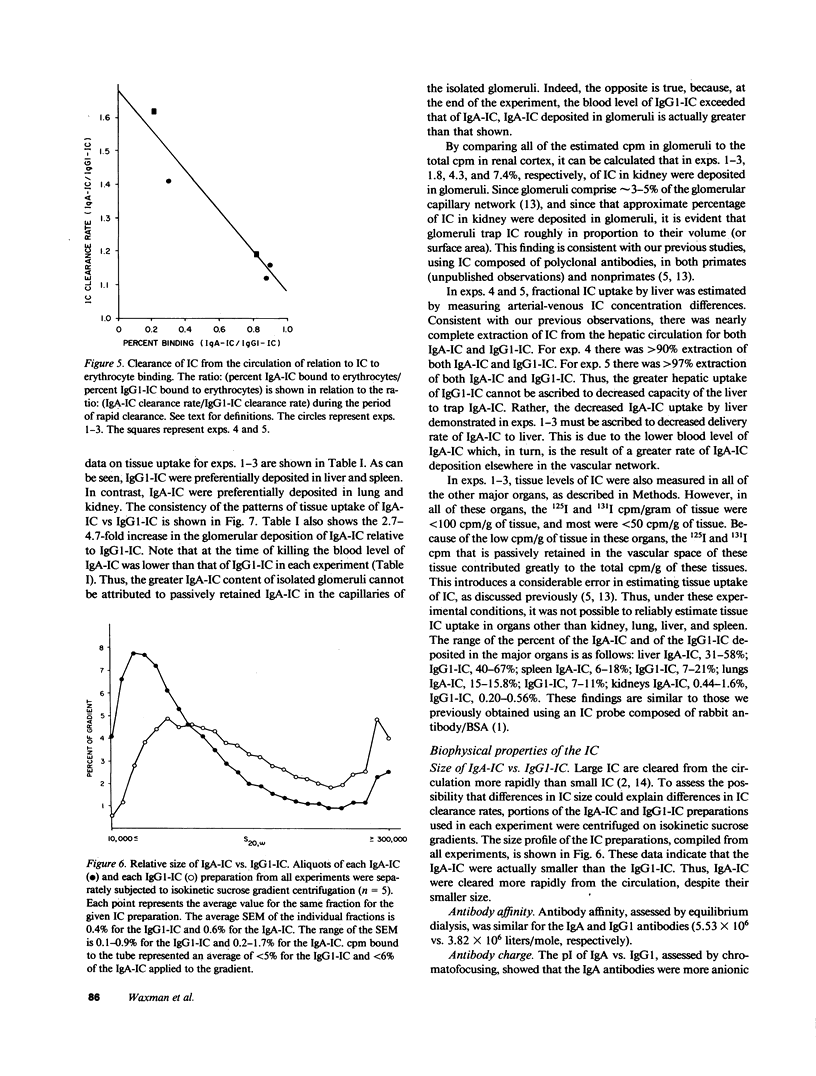
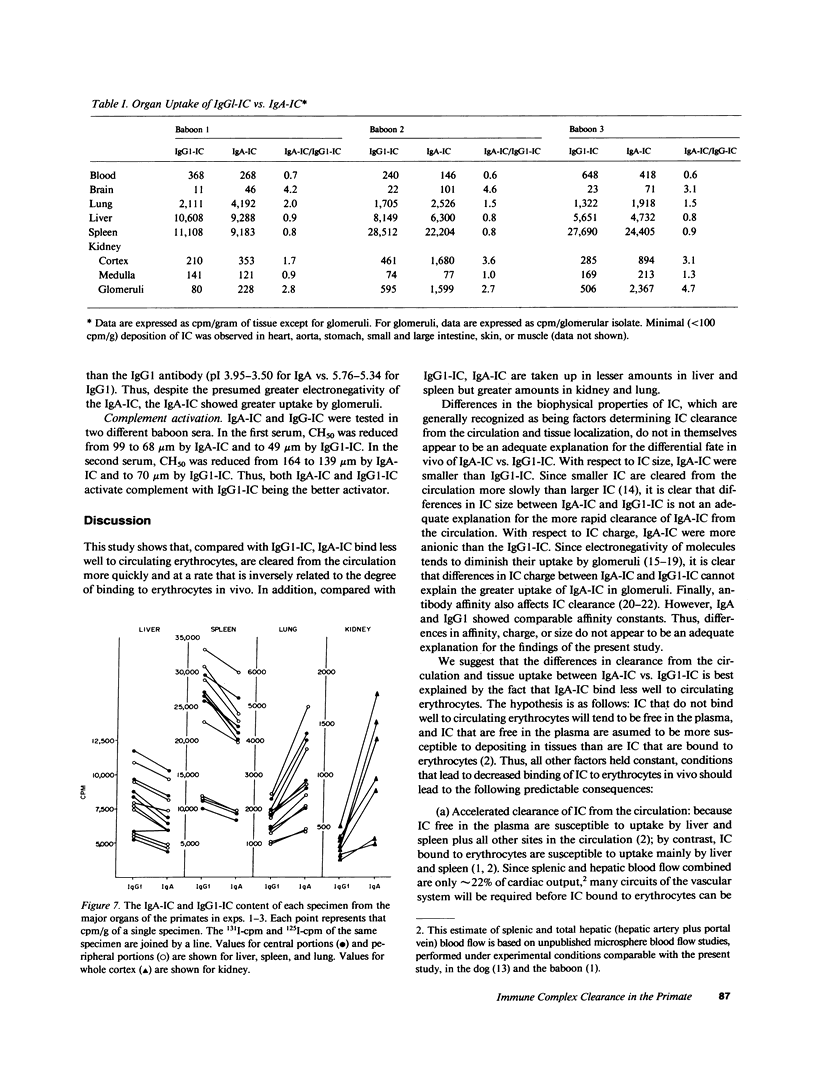
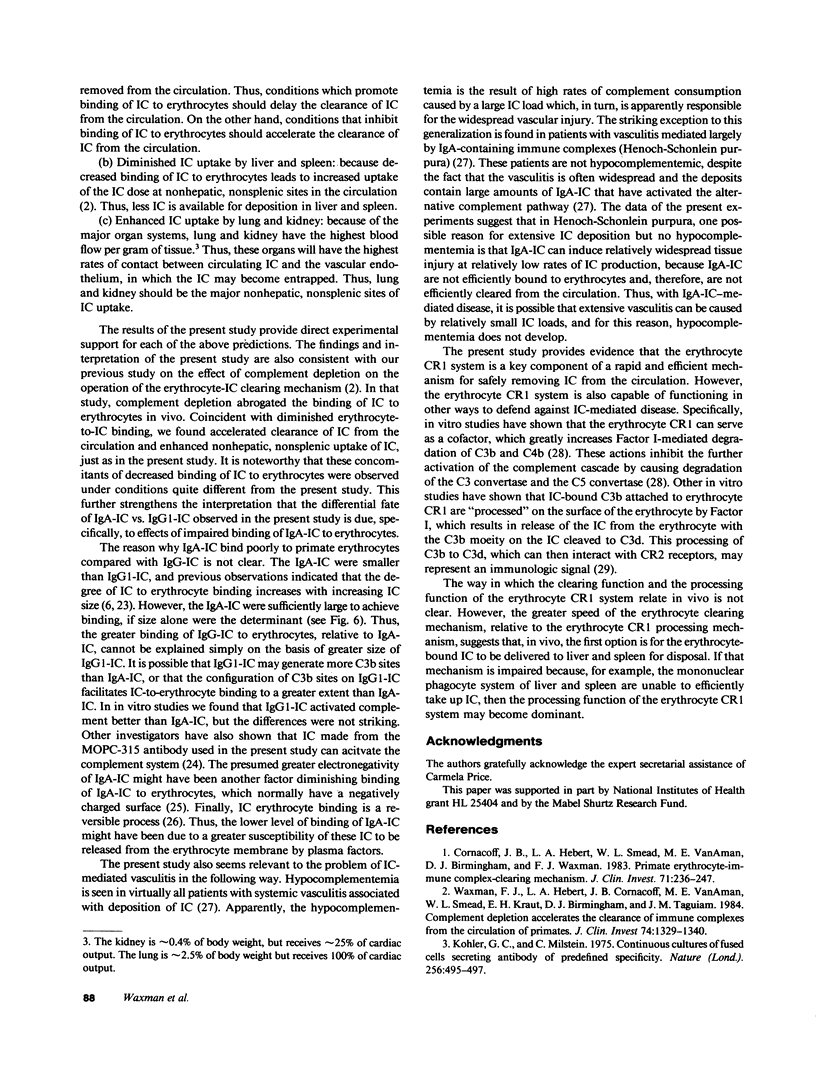
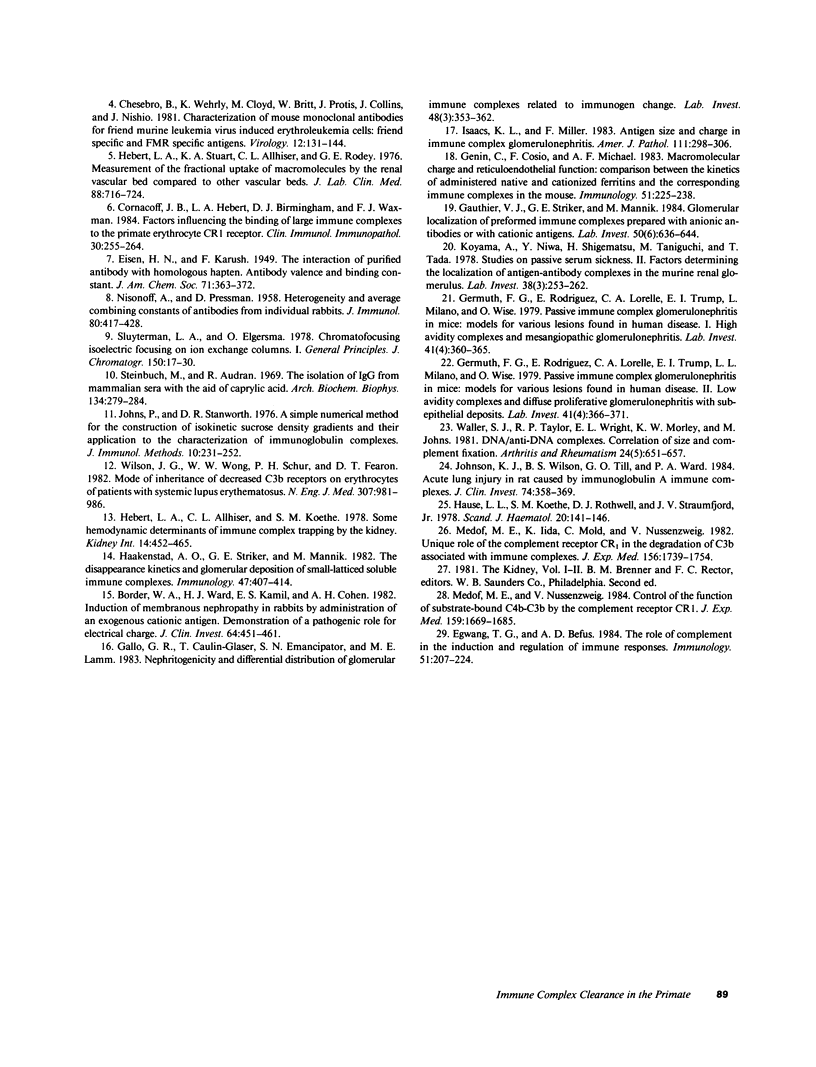
Selected References
These references are in PubMed. This may not be the complete list of references from this article.
- Border W. A., Ward H. J., Kamil E. S., Cohen A. H. Induction of membranous nephropathy in rabbits by administration of an exogenous cationic antigen. J Clin Invest. 1982 Feb;69(2):451–461. doi: 10.1172/JCI110469. [DOI] [PMC free article] [PubMed] [Google Scholar]
- Chesebro B., Wehrly K., Cloyd M., Britt W., Portis J., Collins J., Nishio J. Characterization of mouse monoclonal antibodies specific for Friend murine leukemia virus-induced erythroleukemia cells: friend-specific and FMR-specific antigens. Virology. 1981 Jul 15;112(1):131–144. doi: 10.1016/0042-6822(81)90619-x. [DOI] [PubMed] [Google Scholar]
- Cornacoff J. B., Hebert L. A., Birmingham D. J., Waxman F. J. Factors influencing the binding of large immune complexes to the primate erythrocyte CR1 receptor. Clin Immunol Immunopathol. 1984 Feb;30(2):255–264. doi: 10.1016/0090-1229(84)90060-6. [DOI] [PubMed] [Google Scholar]
- Cornacoff J. B., Hebert L. A., Smead W. L., VanAman M. E., Birmingham D. J., Waxman F. J. Primate erythrocyte-immune complex-clearing mechanism. J Clin Invest. 1983 Feb;71(2):236–247. doi: 10.1172/JCI110764. [DOI] [PMC free article] [PubMed] [Google Scholar]
- Egwang T. G., Befus A. D. The role of complement in the induction and regulation of immune responses. Immunology. 1984 Feb;51(2):207–224. [PMC free article] [PubMed] [Google Scholar]
- Gallo G. R., Caulin-Glaser T., Emancipator S. N., Lamm M. E. Nephritogenicity and differential distribution of glomerular immune complexes related to immunogen charge. Lab Invest. 1983 Mar;48(3):353–362. [PubMed] [Google Scholar]
- Gauthier V. J., Striker G. E., Mannik M. Glomerular localization of preformed immune complexes prepared with anionic antibodies or with cationic antigens. Lab Invest. 1984 Jun;50(6):636–644. [PubMed] [Google Scholar]
- Genin C., Cosio F., Michael A. F. Macromolecular charge and reticuloendothelial function: comparison between the kinetics of administered native and cationized ferritins and the corresponding immune complexes in the mouse. Immunology. 1984 Feb;51(2):225–238. [PMC free article] [PubMed] [Google Scholar]
- Germuth F. G., Jr, Rodriguez E., Lorelle C. A., Trump E. I., Milano L. L., Wise O. Passive immune complex glomerulonephritis in mice: models for various lesions found in human disease. II. Low avidity complexes and diffuse proliferative glomerulonephritis with subepithelial deposits. Lab Invest. 1979 Oct;41(4):366–371. [PubMed] [Google Scholar]
- Germuth F. G., Jr, Rodriguez E., Lorelle C. A., Trump E. I., Milano L., Wise O. Passive immune complex glomerulonephritis in mice: models for various lesions found in human disease. I. High avidity complexes and mesangiopathic glomerulonephritis. Lab Invest. 1979 Oct;41(4):360–365. [PubMed] [Google Scholar]
- Haakenstad A. O., Striker G. E., Mannik M. The disappearance kinetics and glomerular deposition of small-latticed soluble immune complexes. Immunology. 1982 Nov;47(3):407–414. [PMC free article] [PubMed] [Google Scholar]
- Hause L. L., Koethe S. M., Rothwell D. J., Straumfjord J. V. Relations between surface charge and in vitro lysis of red blood cells in paroxysmal nocturnal haemoglobinuria. Scand J Haematol. 1978 Feb;20(2):141–146. doi: 10.1111/j.1600-0609.1978.tb02438.x. [DOI] [PubMed] [Google Scholar]
- Hebert L. A., Allhiser C. L., Koethe S. M. Some hemodynamic determinants of immune complex trapping by the kidney. Kidney Int. 1978 Nov;14(5):452–465. doi: 10.1038/ki.1978.150. [DOI] [PubMed] [Google Scholar]
- Hebert L. A., Stuart K. A., Allhiser C., Rodey G. E. Measurement of the fractional uptake of macromolecules by the renal vascular bed compared to other vascular beds. J Lab Clin Med. 1976 Nov;88(5):716–24716-24. [PubMed] [Google Scholar]
- Isaacs K. L., Miller F. Antigen size and charge in immune complex glomerulonephritis. II. Passive induction of immune deposits with dextran-anti-dextran immune complexes. Am J Pathol. 1983 Jun;111(3):298–306. [PMC free article] [PubMed] [Google Scholar]
- Johns P., Stanworth D. R. A simple numerical method for the construction of isokinetic sucrose density gradients, and their application to the characterisation of immunoglobulin complexes. J Immunol Methods. 1976 Mar;10(2-3):231–252. doi: 10.1016/0022-1759(76)90174-5. [DOI] [PubMed] [Google Scholar]
- Johnson K. J., Wilson B. S., Till G. O., Ward P. A. Acute lung injury in rat caused by immunoglobulin A immune complexes. J Clin Invest. 1984 Aug;74(2):358–369. doi: 10.1172/JCI111431. [DOI] [PMC free article] [PubMed] [Google Scholar]
- Koyama A., Niwa Y., Shigematsu H., Taniguchi M., Tada T. Studies on passive serum sickness. II. Factors determining the localization of antigen-antibody complexes in the murine renal glomerulus. Lab Invest. 1978 Mar;38(3):253–262. [PubMed] [Google Scholar]
- Köhler G., Milstein C. Continuous cultures of fused cells secreting antibody of predefined specificity. Nature. 1975 Aug 7;256(5517):495–497. doi: 10.1038/256495a0. [DOI] [PubMed] [Google Scholar]
- Medof M. E., Iida K., Mold C., Nussenzweig V. Unique role of the complement receptor CR1 in the degradation of C3b associated with immune complexes. J Exp Med. 1982 Dec 1;156(6):1739–1754. doi: 10.1084/jem.156.6.1739. [DOI] [PMC free article] [PubMed] [Google Scholar]
- Medof M. E., Nussenzweig V. Control of the function of substrate-bound C4b-C3b by the complement receptor Cr1. J Exp Med. 1984 Jun 1;159(6):1669–1685. doi: 10.1084/jem.159.6.1669. [DOI] [PMC free article] [PubMed] [Google Scholar]
- NISONOFF A., PRESSMAN D. Heterogeneity and average combining constants of antibodies from individual rabbits. J Immunol. 1958 Jun;80(6):417–428. [PubMed] [Google Scholar]
- Steinbuch M., Audran R. The isolation of IgG from mammalian sera with the aid of caprylic acid. Arch Biochem Biophys. 1969 Nov;134(2):279–284. doi: 10.1016/0003-9861(69)90285-9. [DOI] [PubMed] [Google Scholar]
- Waller S. J., Taylor R. P., Wright E. L., Morley K. W., Johns M. DNA/anti-DNA complexes: correlation of size and complement fixation. Arthritis Rheum. 1981 May;24(5):651–657. doi: 10.1002/art.1780240504. [DOI] [PubMed] [Google Scholar]
- Waxman F. J., Hebert L. A., Cornacoff J. B., VanAman M. E., Smead W. L., Kraut E. H., Birmingham D. J., Taguiam J. M. Complement depletion accelerates the clearance of immune complexes from the circulation of primates. J Clin Invest. 1984 Oct;74(4):1329–1340. doi: 10.1172/JCI111543. [DOI] [PMC free article] [PubMed] [Google Scholar]
- Wilson J. G., Wong W. W., Schur P. H., Fearon D. T. Mode of inheritance of decreased C3b receptors on erythrocytes of patients with systemic lupus erythematosus. N Engl J Med. 1982 Oct 14;307(16):981–986. doi: 10.1056/NEJM198210143071604. [DOI] [PubMed] [Google Scholar]


